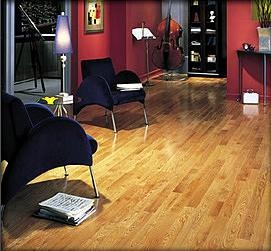
What is a homeowner to do when they wish to install hardwood or bamboo flooring in a room of their home, but the experts advise against it? They turn to engineered hardwood flooring, of course! Far more authentic and attractive than any laminate or vinyl floor, engineered hardwood gives homeowners the freedom of design back.
The Duality of Engineered Hardwood Flooring With engineered floors, you are free to consider the possibilities of using hardwood in areas that would mean disaster for a solid hardwood floor. Engineered hardwood floors allow you all of the beauty and organic feel, as well as a greater range of options as far as the location of your installation. Engineered hardwood floors have the dual features of an attractive top layer that is a real hardwood species and a core which is designed to shift and move with climatic changes.
Engineered Hardwood Flooring and Harsh Environments This duality is what makes engineered hardwood flooring is perfect for a basement floor installation, or an installation in a summer home or cottage that is not environmentally controlled all year round. Along with these functional benefits, engineered hardwood floors are often less expensive than their solid hardwood counterparts, making them worth serious consideration on a budgetary level. With all of its features that allow these advantages, engineered hardwood truly stands as being in a class by itself.
Engineered Hardwood Flooring Dos: Consider the area where you will be installing your engineered hardwood floor in terms of moisture levels and foot traffic. Use this to help you to choose the species of flooring that is right for what you have in mind. Allow for a certain level of wastage per square foot when placing an order, depending on your level of expertise. You are the best judge of how much this will be, but a good range in general is 7-10% for non-professional installers. Read all installation instructions and warranty information very carefully. Consult any information about your radiant heating system in order to learn the best practice when using it under an engineered hardwood floor. Remember to Inspect Your Engineered Hardwood You should also inspect your batch of engineered hardwood flooring for any defects before you begin an installation. Make sure that your subfloor is clean, dry and level before you install your engineered flooring. Clean your engineered hardwood floors frequently, seeing to spills immediately using DRY or DAMP mops, vacuums, and cloths. Finally, use natural fiber rugs and runners to protect high traffic areas and access points to the outdoors. This will minimize the amount of dirt and grit that can negatively affect the finish of your engineered hardwood flooring.
Engineered Hardwood Flooring Don’ts You should never use wax-based cleaners, harsh detergents, abrasives, steel wool, or other flooring products not recommended by the manufacturer to clean engineered hardwood flooring. Do not attempt to apply finish to an engineered hardwood floor that has already been finished at the factory. This could result in irreparable damage and voided warranties. Finally, don’t over wet engineered hardwood when cleaning; excessive moisture can still have a negative effect on your flooring, just as it would with solid hardwood.
Follow these tips and you can enjoy hardwood floors for many years to come in places that you would have previously thought impossible. It’s good to have a choice when it comes to your home’s building materials. Engineered hardwood floors give you just that.





